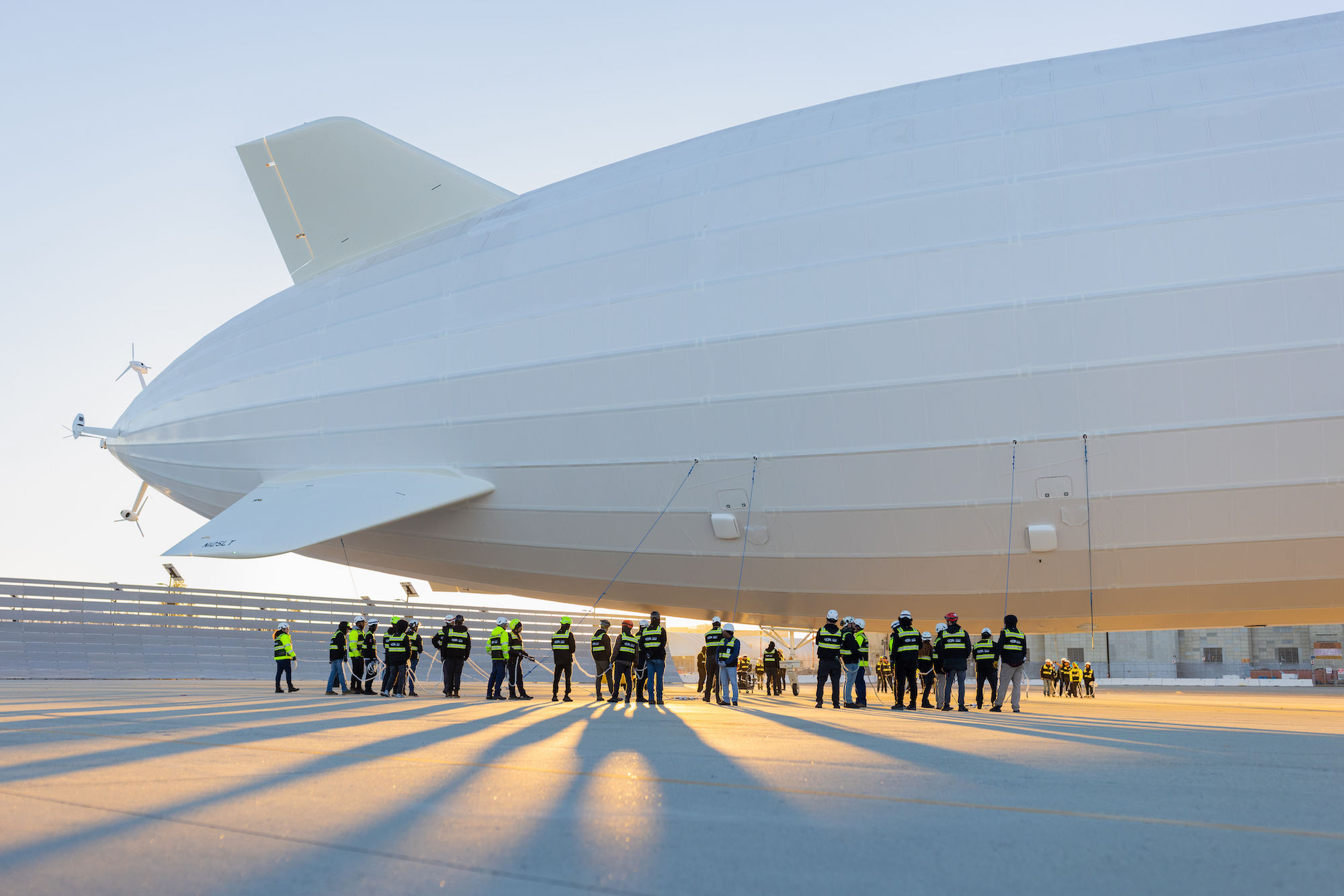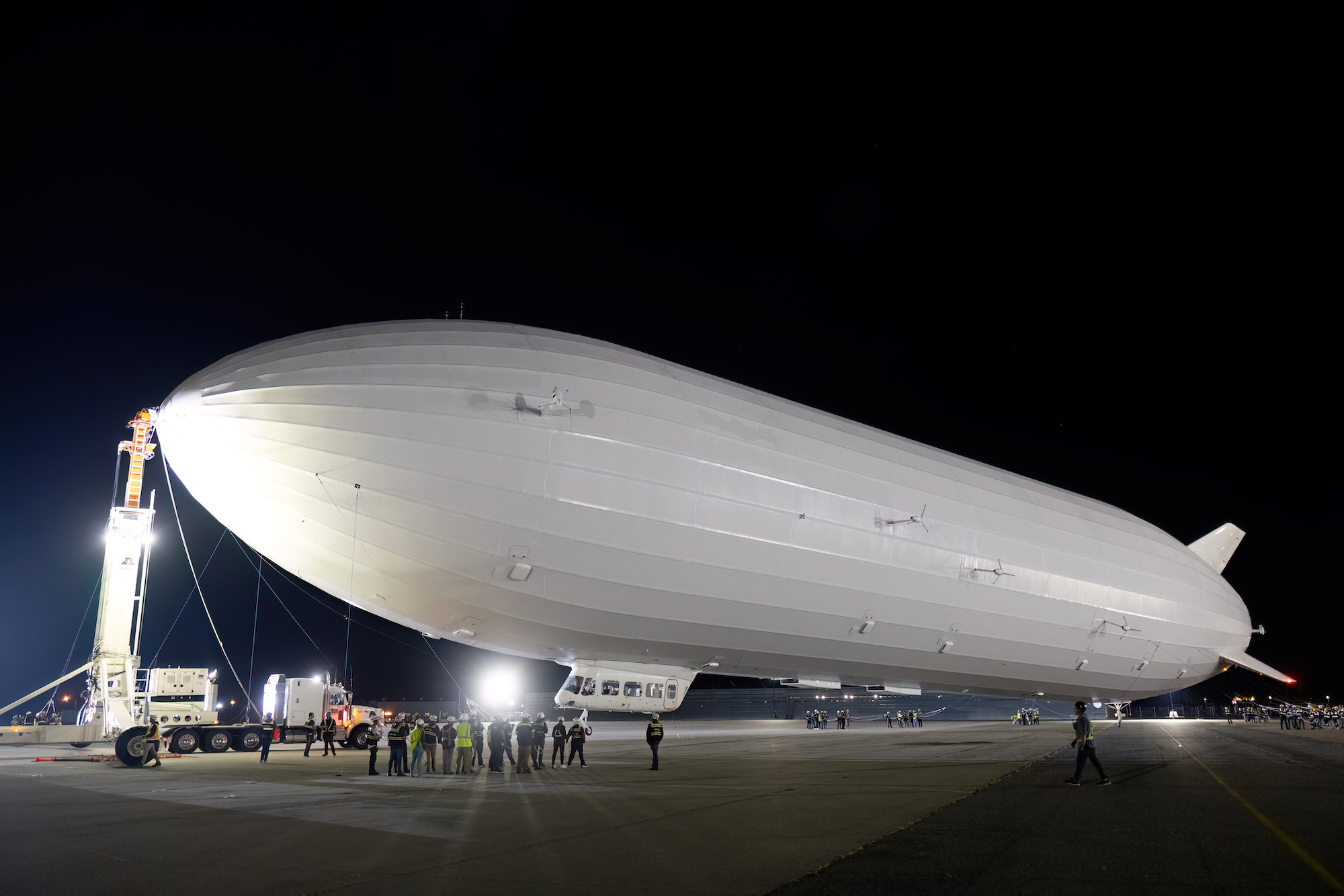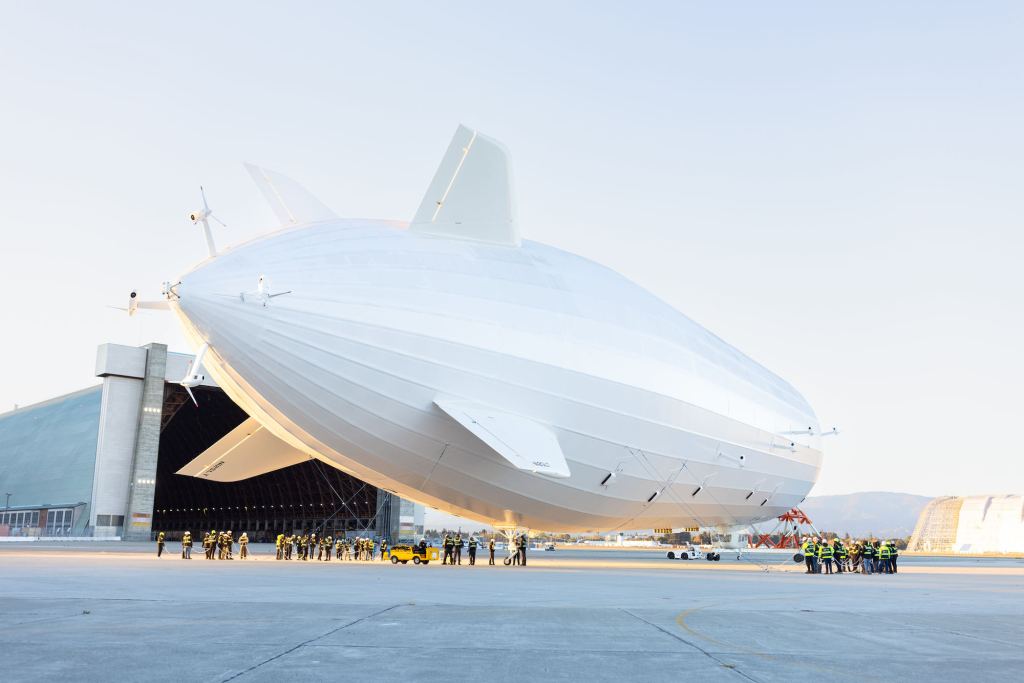As dawn breaks over Silicon Valley, the world is getting its first look at Pathfinder 1, a prototype electric airship that its maker LTA Research hopes will kickstart a new era in climate-friendly air travel, and accelerate the humanitarian work of its funder, Google co-founder Sergey Brin.
The airship — its snow-white steampunk profile visible from the busy 101 highway — has taken drone technology such as fly-by-wire controls, electric motors and lidar sensing, and supersized them to something longer than three Boeing 737s, potentially able to carry tons of cargo over many hundreds of miles.
“It’s been 10 years of blood, sweat and tears,” LTA CEO Alan Weston told TechCrunch on the eve of the unveiling. “Now we must show that this can reliably fly in real-world conditions. And we’re going to do that.”
A series of increasingly ambitious flight tests lie ahead, before Pathfinder 1 is moved to Akron, Ohio, where LTA Research is planning an even larger airship, the Pathfinder 3. The company eventually hopes to produce a family of airships to provide disaster relief where roads and airports are damaged, as well as zero-carbon passenger transportation.
For the next year however, the gigantic airship looks set to become a Silicon Valley landmark as its novel materials and systems are methodically put through their paces within shouting distance of companies like Google, Meta and Amazon. “I’m excited about the potential of not building just one airship, but laying the foundation for many airships to be built,” said Weston. “The innovations and the technologies that we’re about to demonstrate have the potential to lay the foundation for a new industry.”
The biggest aircraft in almost a century

At 124.5 meters long, Pathfinder 1 dwarfs the current Goodyear airships and even the massive Stratolaunch plane designed to launch orbital rockets. It’s the largest aircraft to take to the skies since the gargantuan Hindenburg airship of the 1930s. Although similar in appearance to that ill-fated airship, and using a passenger gondola supplied by Zeppelin, the Pathfinder 1 was mostly built from the ground up using new materials and technologies.
LTA’s airship uses stable helium rather than flammable hydrogen as a lifting gas, held in 13 giant rip-stop nylon cells and monitored by lidar laser systems. A rigid framework of 10,000 carbon-fiber reinforced tubes and 3,000 titanium hubs form a protective skeleton around the gas cells, surrounded by a lightweight synthetic Tedlar skin.
Twelve electric motors powered by diesel generators and batteries enable vertical take-off and landing. They can propel the Pathfinder 1 at up to 65 knots (75 mph), although its initial flights will be at much lower speeds.
This morning, the airship floated silently from its WW2-era hangar at NASA’s Moffett Field at walking pace, steered by ropes held by dozens of the company’s engineers, technicians and ground crew.
The whole operation occurred under the cover of darkness, not because LTA has something to hide but because the airship’s flight test program begins with the first rays of the morning sun. The first lesson its engineers hope to learn is how Pathfinder 1’s approximately one million cubic feet of helium and weather resistant polymer skin will respond to the warming effect of Californian sunshine.
“We have sophisticated methodology that allows us to replicate real-world conditions using static test stands,” said Jillian Hilenski, senior mechanical engineer at LTA. “However, dynamic on-ship flight tests provide the best data on the health and efficiency of the airship.”
Test, test, test again

At the start of September, the FAA issued a special airworthiness certificate for the Pathfinder 1 allowing test flights in and around Moffett Field and the nearby Palo Alto airport, and over the southern part of the San Francisco Bay.
Those tests will initially happen just a few feet off the ground, with the airship tethered to a mobile tripod mast. These will be followed by simple maneuvers around Moffett Field, before a series of flights out and over the Bay.
“The advantages of going over the water are multiple,” said Weston. “First of all, when you come off Moffett Field, the air is smoother over the Bay than it is anywhere else. That’s very important. And there’s not much in the way of traffic on the surface, so that’s a big plus as well.”
Safety is top of Weston’s mind as he works to reintroduce rigid airships to the skies of North America — and ultimately the world. The first 50 flights of Pathfinder 1 covered by the FAA certificate will allow flights no higher than 1,500 feet, and will use two pilots rather than the single pilot the airship was designed to need.
“I can count the number of companies in the lighter-than-air space on my hands, and we all have a lot to lose if anybody has a serious problem,” he said. Weston says LTA is working closely with the FAA to ensure that anything the company builds has a safe and sensible path to full certification. “The last maiden flight of an airship like this was the Graf Zeppelin II in 1938,” he noted during the interview. “The FAA wasn’t even around then.”
Back to the future
In a world of eVTOL air-taxis, electric aviation startups and hydrogen planes, Weston acknowledges that airships are only ever likely to be a partial solution. “I can’t see airships replacing aircraft,” he said. “But I do see a niche for airships to be part of the transportation architecture that reduces the carbon footprint of air travel.”
Another important niche could be responding to natural disasters like earthquakes, volcanic eruptions and hurricanes. Sergey Brin also funds a nonprofit called Global Support and Development that aims to deliver humanitarian aid within the first 24 to 96 hours of a disaster.
Brin founded GSD in 2015 after using his own superyacht to deploy medics to the scene of a cyclone in the South Pacific. The nonprofit has since partnered with the nonprofit YachtAid Global, and now also has its own purpose-built vessel, the MV Dawn, that can swiftly transport dozens of doctors and aid workers, alongside life-saving supplies.
While Pathfinder 1 can carry about four tons of cargo in addition to its crew, water ballast and fuel, future humanitarian airships will need much larger capacities. They will also likely use zero-carbon technologies like hydrogen fuel cells for power, said Hilenski. That will involve a long, slow slog to validate the new technologies and to demonstrate, to the FAA and paying customers, that a new generation of super-large airships can match the generally excellent safety and reliability record of today’s commercial jets.
“What excites me about what we’ve done so far is that we’ve shown to ourselves, and we hope to show to the rest of the world, that we can scale in size and productivity,” said Weston. “And I believe in our potential to scale up again in the future.”
The FAA’s experimental certificate for the Pathfinder 1 expires in September 2024.































Comment